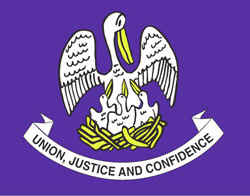
4th Company, Washington Battalion Volunteer Artillery (Eshleman's, Norcom's)
Orleans

From Sifakis, Compendium of C.S. Armies: Louisiana, 33-34, 37-39:
Washington Battalion
Organization: Organized at New Orleans as a battery in 1838. Mustered into Confederate service for the war with four companies in Lafayette Square, New Orleans on May 26, 1861. ... Captured as part of Walker's artillery column on April 8, 1865.
First Commander: James B. Walton, MAJ, COL [promoted & detached, February 1864]
Field Officers: Benjamin F. Eshleman, MAJ, LTC [February 27,1864]; Merritt B. MILLER, MAJ; William M. Owen, MAJ [assigned April 10, 1864], LTC
From Bergeron, La. Confed. Units, 14-16:
Washington Battalion
"Probably the most famous Louisiana unit in the Confederate army next to Wheat's Tiger Battalion, the Washington Artillery traces its lineage back to 1838 in the state militia. Four companies entered Confederate service on May 26, 1861, and left for Virginia. On arrival at Manassas Junction, the battalion lost 1 officer and 5 enlisted men in its first skirmish, at Blackburn's Ford, July 18, 1861. In the Battle of Manassas, July 21, the battalion performed gallant service and received praise from General Pierre G. T. Beauregard for its "skill, conduct, and soldierly qualities." During the fall and winter of 1861, the battalion occupied camps in the vicinity of Manassa and Centreville; and detachments from the battalion engaged in several skirmishes in the area. The battalion received orders to join General James Longstreet's division on March 5, 1862, and was connected with that general's command throughout most of the remainder of the war. Shortly after this assignment, the battalion accompanied the army on its retreat to Orange Court House and moved to Richmond about April 12. From Richmond the battalion marched down the peninsula and participated in the closing stages of the Yorktown Campaign. The 2nd Company fought in a skirmish at Mechanicsville on May 23, and the 1st Company was engaged at New Bridge on June 5. During the Seven Days' Battles, the battalion was held in reserve and not engaged. The 1st Company engaged several enemy vessels on the James River near Charles City Court House, July 5-7. On August 23, the battalion helped drive the enemy back in a skirmish at Rappahannock Station. The battalion fought at the Battle of Second Manassas, August 29-31; 1 man was killed and 9 were wounded. In the Battle of Sharpsburg, September 17, the battalion helped repulse several enemy attacks. At one point, when the men of the 3rd Company had become exhausted, General Longstreet and his staff assisted in working the guns. The battalion occupied quarters at Winchester, Virginia, after the retreat from Maryland, and on November 22 it reached Fredericksburg. During the Battle of Fredericksburg, December 13, three companies of the battalion occupied positions atop Marye's Heights and helped throw back the numerous enemy assaults on the Confederate lines. The 2nd Company was in reserve during the battle. The battalion occupied winter quarters near Fredericksburg. When the Chancellorsville Campaign began, the battalion once again defended Marye's Heights. On May 3, 1863, the enemy attacked and overran the battalion's position, capturing six guns and 33 men. The battalion arrived on the battlefield of Gettysburg on July 2. The next day, the men participated in the long artillery duel that preceded Pickett's Charge. During the retreat back to Virginia, the battalion fought in an engagement at Williamsport on July 6. After a brief stop at Orange Court House, the battalion proceeded to Petersburg in September to occupy part of that city's defensive works. Not until May, 1864, did the battalion again engage the enemy. The men participated in the successful defense of Drewry's Bluff, May 12-16. After a brief assignment to cover several fords over the Chickahominy River east of Richmond in June, the battalion returned to the Petersburg defenses. The battalion participated in the lengthy siege operations around the city, July, 1864-April, 1865. Small detachments of the 3rd Company played a gallant role in the defense of Fort Gregg and Fort Whitworth on April 2 but were overrun and captured. During the retreat toward Appomattox, the battalion, along with several other artillery units, got separated from the rest of the army. Hearing of General Robert E. Lee's surrender, the men destroyed their gun carriages near Amelia Court House and started making their way toward home. Three officers and 27 enlisted men were paroled with Lee's army at Appomattox. Approximately 719 men served in the battalion during the war. Of that number, 62 died in battle, 2 were killed in accidents, 1 drowned, and 20 died of disease."
From Bergeron, La. Confed. Units, 14:
4th Company
"4th Company (Orleans). Benjamin F. Eshleman, promoted major March 26, 1862; Joseph Norcom."
CSRC, M320, rolls 62-71 [entire battalion]
ROSTER
ADAMS, Charles L. Cpl. // CSRC, Index.
ADAMS, Joseph. Pvt. // CSRC, Index.
JOUBERT, Eugene. Pvt. // CSRC, Index. // Served also in 3rd Company, this battalion.
SMITH, Henry. Pvt. // CSRC, Index.
SMITH, James. Pvt. // CSRC, Index. // Served also in 1st Company, this battalion.
SMITH, J. H. Pvt. // CSRC, Index.
TERREBONNE, E. D. Pvt. // CSRC, Index. // Served also in Company A, Miles' Legion Infantry as 1LT.
7 4th Co., Washington Bn. Arty.
Individuals from non-Cajun families, CSRC Index
ALLEN, J. S. Pvt. AMES Fred W. Cpl. ANDERSON, George. Driver APPS, George E. LT. 4 [top of page 4th Co., Washington Bn. Arty.]
copyright (c) 2003-05 Steven A. Cormier